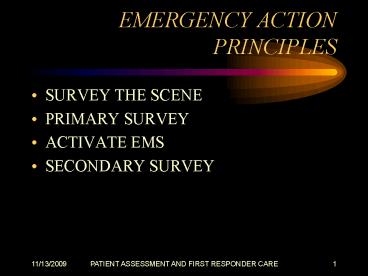EMERGENCY ACTION PRINCIPLES - PowerPoint PPT Presentation
1 / 15
Title:
EMERGENCY ACTION PRINCIPLES
Description:
Check for unsafe conditions that will threaten your safety ... Start at the head ending at the toes,checking for any abnormal conditions. Use your senses to: ... – PowerPoint PPT presentation
Number of Views:1579
Avg rating:3.0/5.0
Title: EMERGENCY ACTION PRINCIPLES
1
EMERGENCY ACTION PRINCIPLES
- SURVEY THE SCENE
- PRIMARY SURVEY
- ACTIVATE EMS
- SECONDARY SURVEY
2
Survey The Scene
- To determine if it is safe to proceed with the
rescue. - Avoid all dangerous situations.
- If you are not properly trained and do not have
the necessary equipment do not approach the
victim. - Never risk your own life
3
Before You Approach The Victim
- Check for unsafe conditions that will threaten
your safety and that of the bystanders - Look for clues and try to find out what happened
- Dangers include downed power lines, traffic,
fire, unstable structures, deep or swift moving
water - If conditions change, you may then be able to
approach the victim or victims - Ask bystanders for information or for help
- Speak to victim in a calm reassuring manner
4
Primary Survey
- This procedure takes a few seconds and is the
difference between life and death. - The Primary survey is also referred to as the
ABCs. - This principle is the basis of our class
- You will be able to observe signs of life
threatening conditions
5
PATIENT ASSESSMENT
- You check to see of the victim
- IS CONSCIOUS
- HAS AN OPEN AIRWAY
- IS BREATHING
- HAS A HEARTBEAT
- IS BLEEDING SEVERELY
- The primary survey takes only seconds to perform
6
Check The Airway
- A victim who can talk or cry is conscious and has
an open airway - Open the victims airway if the victim is
unconscious - Head Tilt/ Chin Lift
- This action moves tongue away from the airway
- Check for Breathing
- Airway may be obstructed by food, liquid, or
other objects
7
CHECK BREATHING
- Look, listen and feel for signs of breathing
- If victim is breathing chest will rise and fall
- Position yourself so you can hear and feel air as
it escapes from victims nose and mouth - If victim is not breathing you must breathe for
the victim - This is called RESCUE BREATHING
8
CHECK CIRCULATION
- Check for blood circulation or pulse
- Check for severe bleeding
- If the heart has stopped blood will not circulate
throughout the body - If the victim is breathing then their heart is
beating and circulating blood - On an infant check the pulse on the brachial
artery - On a child or an adult check the carotid artery
- Check the pulse for _at_5 - 10 seconds
- If no breathing or pulse administer rescue
breathing and chest compressions
9
ACTIVATE EMS
- Summon additional help from advanced medical
personnel if any of the following conditions
exists - Unconsciousness
- Breathing problems
- Persistent chest or abdominal pain
- No pulse
- Severe Bleeding
- Vomiting or passing blood
- Suspected poisoning
- Seizures, severe headache, slurred speech
- Suspected or obvious head or neck injuries
- Suspected fractures
- Severe burns
10
SECONDARY SURVEY
- Once you are certain that the victim has no
life-threatening conditions, you can begin the
secondary survey - You will gather information about the victim and
any conditions that may become life-threatening - Interview the victim and bystanders
- Check vital signs
- Do a head-to-toe examination to check for signs
and symptoms - In some cases you may never have the opportunity
or need to conduct the secondary survey
11
INTERVIEW QUESTIONS
- What happened?
- Do you feel any pain anywhere?
- Do you have any medical conditions?
- Are you taking medications?
- Do you have any allergies?
- These questions may be asked to the parent or
responsible adult if you are working with an
infant or a child
12
CHECKING VITAL SIGNS PULSE
- With every heartbeat a wave of blood moves
through the blood vessels - This creates a beat called the pulse
- A pulse can be checked in arteries that circulate
close to the surface CAROTID BRACHIAL RADIAL - A normal pulse for an adult is _at_60-80BPM
- An abnormal pulse may be sign of a potential
problem - Irregular pulse
- Weak and hard to find pulse
- Excessively fast or slow pulse
13
CHECKING THE VITAL SIGNS Breathing
- A healthy person breathes regularly, quietly, and
effortlessly - Abnormal breathing may indicate a potential
problem such as - Gasping for breath
- Noisy breathing whistling sounds, high pitched
wheezing, gurgling, or snoring - Excessively fast or slow breathing
- Painful breathing
14
HEAD TO TOE EXAMINATION
- Start at the head ending at the toes,checking for
any abnormal conditions - Use your senses to
- Smell unusual odors
- Look for pale or bluish skin, bruises, deformed
body parts - Palpate all tender areas
- Continue to monitor vital signs
- Observe any changes that indicate a life
threatening situation and provide necessary first
responder care
15
8 Steps To Patient Assessment
- Tap and Shout
- Look, Listen and Feel for breathing
- Turn victim over as one unit (rescue position)
- Head Tilt/Chin Lift to move tongue away from back
of airway -modified if head or neck injury is
suspected - Look, listen, feel, for breathing for _at_ 5
seconds, pinch nose, seal your lips over
victims, give two rescue breaths each breath
should last 1½ seconds - Check pulse at carotid artery
- Check for severe bleeding
- Begin necessary and appropriate first responder
care

